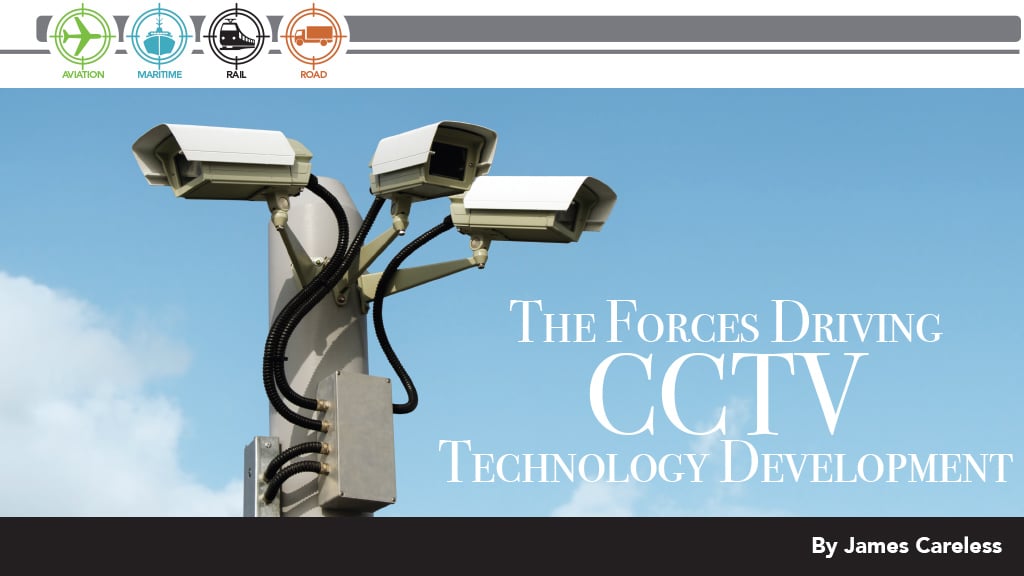CCTV security systems are becoming sharper (in image resolution), smaller (in form factor), and smarter—thanks to artificial intelligence/AI that can detect intruders automatically. For the transportation sector, these advances offer the opportunity to enhance security, personnel, and property protection at any locations where their aircraft, ships, trains, and trucks are vulnerable.
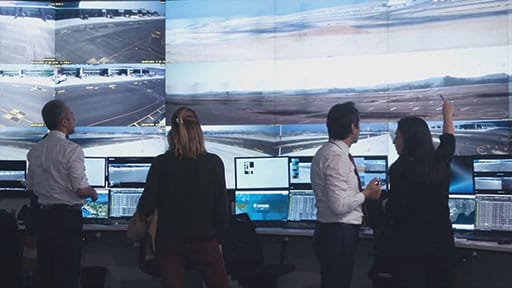
To put these advances into context and to better understand the threats that they are now addressing, TSI magazine posed questions to experts in the CCTV industry. Here is what they told us
What is Driving CCTV Development?
Judging by what the experts told us, there are a myriad of factors shaping the development of CCTV technology today.
The fundamental force is the deteriorating state of security and safety across the globe.
“The threat situation and the geopolitical situation have changed and in many cases have become more acute,” said Josua Braun, marketing director with Dallmeier, a manufacturer of video security products/solutions. “Accordingly, the demands in security are increasing, especially for video systems. Many of our customers report — in addition to the actual protection and security function — that the potential threat from insecure or deliberately open systems is playing an increasingly important role; namely cybersecurity.”
The need to cope with these increasing threat levels are motivating CCTV manufacturers to move far beyond passive CCTV camera feed watched by human monitors. “In the transport sector in particular, in addition to ‘classic’ security applications, we are increasingly seeing process optimizations driven not least by increasingly powerful analysis and AI systems,” Braun told TSI. “Examples of this are virtual/remote tower solutions, systems for the detection of watercraft in port areas, and AI-object classification that help reduce the number of false alarms in perimeter protection, thus optimizing security and the cost situation for clients.”
Johnson Controls is a global player in the transportation security market, offering products and solutions for air, land, sea, and port management. “We provide sensors, cameras, and video management, access control and intrusion solutions that integrate with a wide list of third party products to enhance small, large and enterprise security operations,” said Nathan Floyd, the company’s director of vertical solutions. “We help some of the largest and heaviest trafficked in the transportation industry identify, face and defend against the most substantial risks.”
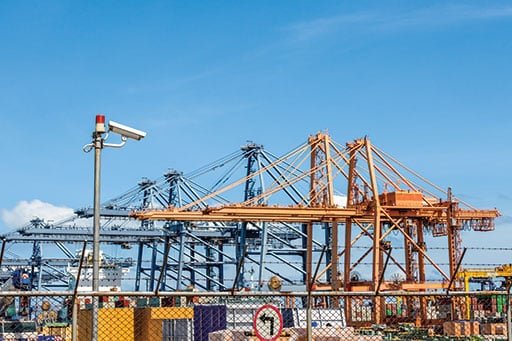
Asked about the factors driving CCTV technology development these days, Floyd offers a laundry list of trends. “They include AI, cloud management, fusion (3D) cameras, increased volume and sophistication of cyber-attacks, increased governmental regulations, operational efficiency (do more with less), employee shortages, and evolving threats,” he said.
Simon (Sam) Samuels is principal consultant with SGW Safety and Security Consultancy in the UK. His assessment of factors influencing the CCTV technology sector is a negative one. “Key trends are (the) defective use of pixel density as a design criteria,” said Samuels; in other words, “relying on manufacturers’ data sheets rather than the requirements of relevant standards and recommended practices.”
Coming from CCTV technology development from an entirely different angle, Mark Steinberg is senior technologist at B&H Photo Video Audio, a consumer/business AV equipment retailer based in New York City. “The IoT (Internet of Things) is of growing interest and becoming increasingly integral to many surveillance products and systems,” he said. For instance, clients want their CCTV camera feeds to be accessible using voice commanded apps and smart speakers, and to be able to see these feeds on their own mobile devices and monitors. “Remote access is paramount for small and medium sized businesses as well. It is also becoming increasingly important in real estate for vacation homes, rental properties and landlords in general,” said Steinberg. In addition, “I have experienced a noticeable uptick of requests for CCTV cameras that can be solar powered.”
How CCTV Suppliers Are Responding
Faced with so many customer needs to be satisfied, CCTV equipment manufacturers, vendors, and consultants are responding to their demands in a variety of ways.
Dallmeier is taking a Big Picture approach to this situation. “We develop and manufacture CCTV camera systems, recording and management and analysis software,” Braun explained. “A key differentiator of our technology is the way we cover large areas with video technology.”
A case in point: “Thanks to our patented ‘PANOMERA’ multifocal sensor cameras, our customers need a significantly smaller number of camera systems than with conventional solutions – and with better detail resolution,” he said. “This increases objective security, especially in the port/airport and logistics sector, provides the basis for good analysis results and significantly reduces the ‘Total Cost of Ownership’.”
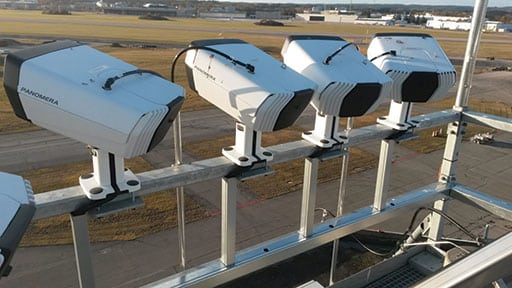
Meanwhile, “Johnson Controls‘ disciplined approach to product lifecycle management allows us to continually innovate with breakthrough edge devices like the Illustra Multisensor camera, a device with four independent motorized cameras built into a single easy-to-install housing,” said Floyd. “With its deep learning AI-enabled capability, the MultiSensor is designed for complete coverage with a faster installation, lower total cost of ownership and consistent software product releases that improve efficiency and add features.” He added that Johnson Controls’ development and operational processes ensure that its software and hardware are well tested and properly supported by a timely assessment of vulnerabilities and over-the-air deployment of patches.
Over at B&H, their strategy is to serve a wide range of business and consumer CCTV customers, rather than one specific sector such as transportation. As a result, “we offer thousands of products in our surveillance category,” Steinberg said. “We offer mostly off-the-shelf and plug-and-play solutions that appeal to the broad security market.”

SGW Safety and Security Consultancy
Finally, Samuels is working to improve the ability of CCTV systems to accurately capture and process video images. “CCTV has been a security tool for many years, and the best tool for assessing the quality of CCTV images has been the Rotakin Test, a 1600mm x 400mm target developed by the UK’s Home Office in the 1980s,” explained his online article, ‘CCTV Video Image Calculator (VIC) & Screen Assessment Matrix (SAM)’. “The new CCTV Video Image Calculator (VIC) & Screen Assessment Matrix (SAM) has been designed within the requirements of IEC 62676-4 (the new measurement standard), to provide the tools necessary for measuring the image quality of CCTV systems, camera setup, commissioning and auditing of CCTV fields of views, which provides for quantified, consistent and repeatable results.” The entire article can be viewed at sgw-consulting.co.uk.
(Note: IEC is the acronym for the International Electrotechnical Commission, the international standards organization that prepares and publishes international standards for all electrical, electronic and related technologies.)
AI and CCTV
The use of AI-enabled processing to enhance, interpret, and recommend action on specific CCTV images has already been touched on in this article. However, this trend is so important that it deserves its own section.
When it comes to CCTV security as a whole, “the analysis of video footage by AI systems is becoming increasingly important,” said Braun. “The areas of application are theoretically limitless: On the one hand, AI can serve as assistance systems in the classic sense to improve objective security performance. On the other hand, there are more and more AI application scenarios that contribute to the optimization of processes, especially in the transport and logistics sector, and thus offer a high cost-saving potential.”
“Artificial Intelligence is extremely beneficial in the transportation market today and will change the industry going forward,” Floyd agreed. “Using deep learning algorithms to build confident models, Johnson Controls systems allow operators to perform daily tasks more efficiently like forensic searches. Captured by cameras with AI now being used as advanced edge sensors that bring near real time escalations or alerts to professionals for evaluation and action.”
Whether for business or consumer CCTV applications, AI-aided cameras with built-in video analytics and/or thermal imaging are regularly requested by B&H customers. “AI cameras that zoom, pan, and rotate without any human input are proving valuable as they can save payroll and human capital while providing safety in hazardous conditions/environments,” said Steinberg. “Combined with thermal cameras and deep learning, AI can provide public safety by detecting people with raised temperatures in all kinds of public spaces like schools and entertainment/sporting venues. AI CCTV applications can be used in healthcare for contactless examinations. AI-assisted cameras and storage systems can provide invaluable assistance to the police, public transportation, traffic control, waste management, marine applications, mining operations, oil rigs, and a host of other businesses and applications.”
This being said, the current level of industry understanding about AI’s full potential in CCTV surveillance leaves something to be desired, Samuels noted. “AI is useful in assessing both behavior analysis (movement, left object, missing objects) and facial recognition,” he allowed. “However, there is a disconnect in the processing and assessment of images which is addressed within IEC 30137-1. Unfortunately, as with IEC 62676, there is a lack of competence within the CCTV industry to comprehend the intent and benefit of these standards”
What’s Next
As we have seen, the state of CCTV technology has moved far beyond low-resolution black and white cameras and monitors, which were watched by human operators often bored out of their minds by the tedium of the job. Thanks to HDTV, computers, and AI, CCTV surveillance has become a proactive and precise science, with AI-enabled systems doing the ‘heavy lifting’ of watching camera feeds for anomalies. Only when something seems amiss are humans called in to make decisions and take action, thus removing boredom from the security equation.
The CCTV technology industry never sleeps. They are constantly striving to make CCTV surveillance systems even sharper, smaller, and smarter.
So, what’s on the horizon? “There is a move to higher and higher resolution cameras,” said Samuels. “This is driven by manufacturers and gullible clients. It would be better to improve the quality of images and optimize them to a single resolution (2160 or 1080) with high speed capture capability.” He also predicted “a deterioration of the quality of images due to the need to over-compress the resultant large files.” plus a “continued deterioration of the quality of installations and designs.”
Samuels isn’t the only expert puzzled by the push for higher resolution cameras. “Funnily enough, camera manufacturers have not really thought about how to optimize the use of the valuable resource of ‘resolution’,” Braun observed. “We still have far more pixels than necessary in the front image area, and too few in the back. Dallmeier has broken through this seemingly ‘physical truth’ with our multifocal sensor technology — to the advantage of customers, who have a much better overview with fewer cameras and absolute detail accuracy.”
At Johnson Controls, Nathan Floyd is expecting significant advancements in automated CCTV responses without human intervention. “Automated responses reduce time delays while improving safety and security when threats are present,” he said. “The future will also see more open standards wrapped with cloud technology that bring together the smarts of intelligent systems, buildings, and cities.”
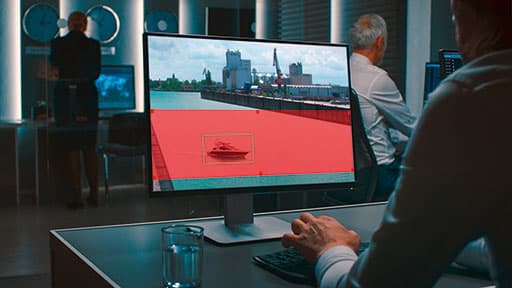
B&H’s Steinberg believes that the latest generation of mobile telephone transmissions — 5G — should significantly improve the performance and accessibility of wireless CCTV cameras connected over these networks. “5G is 100 times faster than 4G, handles more devices with less bandwidth and at lower bit rates, handling them all simultaneously,” he explained. At the same time, optimized encoding will help lower bit rates and bandwidth use, thereby lowering the amount and cost of CCTV video storage, thus providing users with better returns on their investment, said Steinberg. “Improved AI and deep learning integration will help implement, deploy, and maintain surveillance and access systems lowering the overall acquisition costs and maintenance costs.”
Another trend that will affect CCTV’s future: “The convergence of imaging and analysis techniques is only just beginning — we will see many more interesting applications here!” Braun said. “At the same time, of course, we also expect new regulations when it comes to things like facial recognition. The world of video technology is and will remain exciting!”
The bottom line: “CCTV is a critical component to securing the transportation vertical,” said Floyd. Its importance in enhancing this security will only grow in years to come as the threats become more diverse and dangerous, and the technology more adept at anticipating and foiling them.
